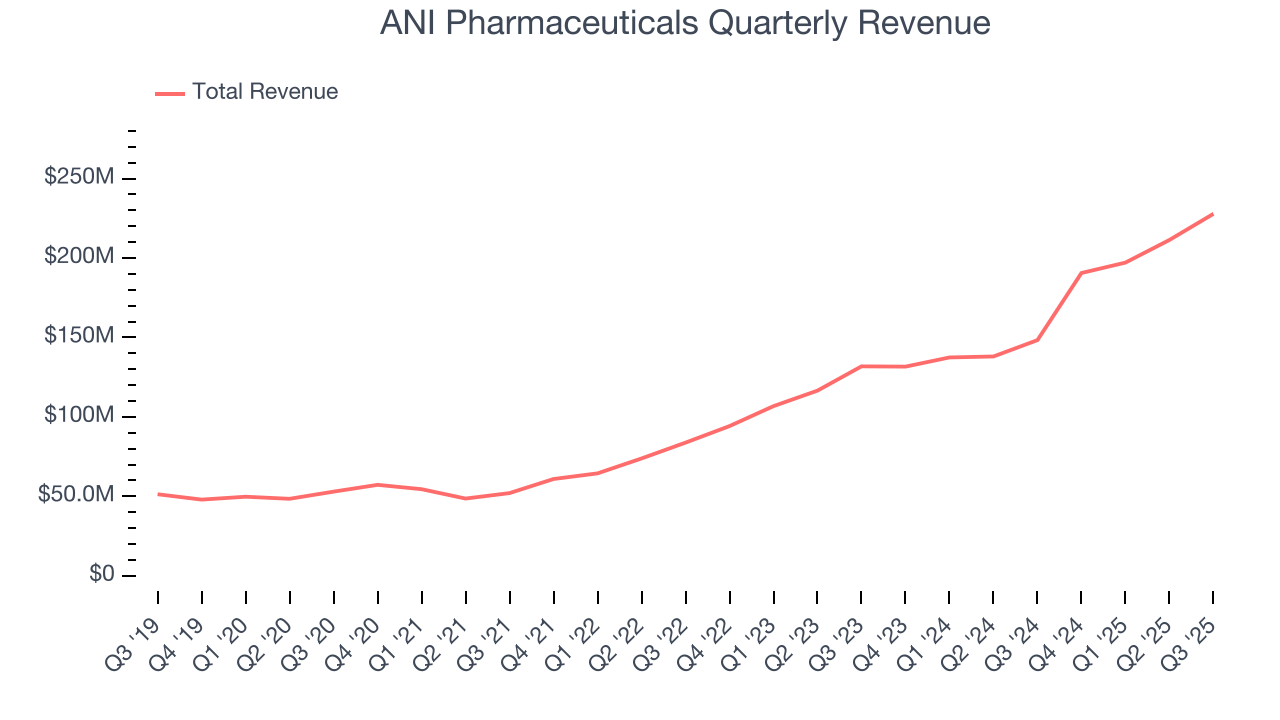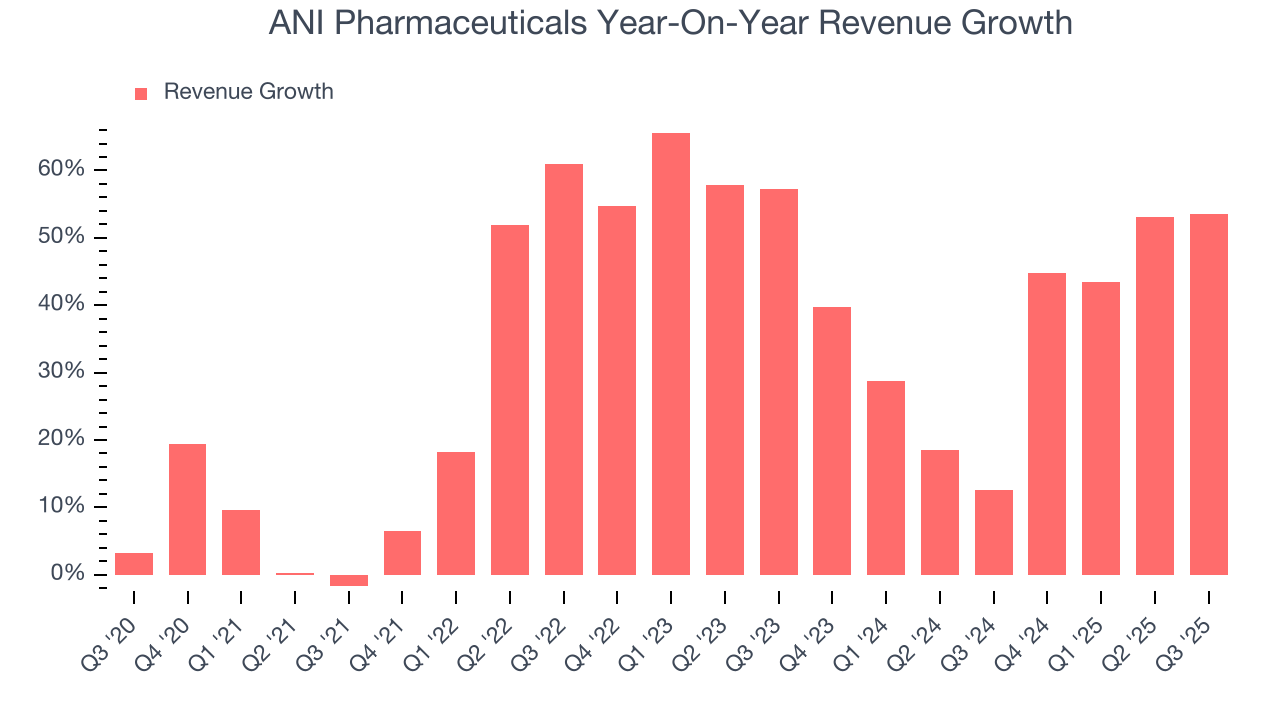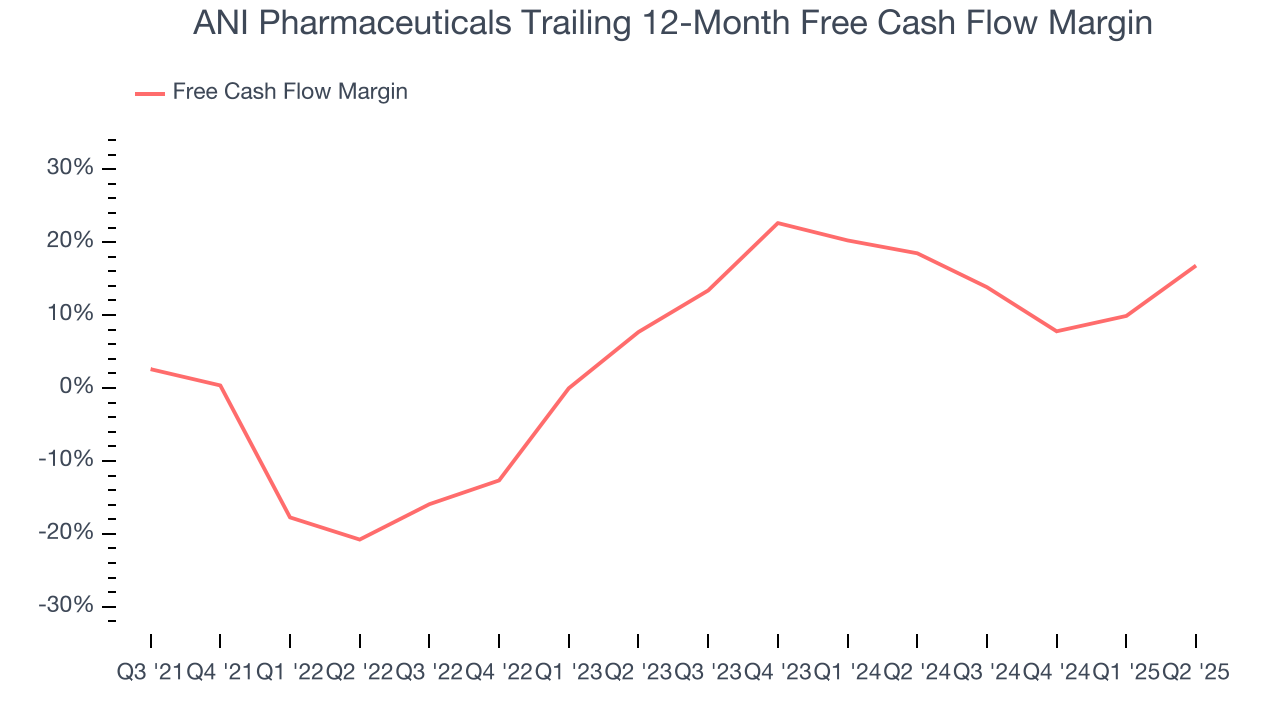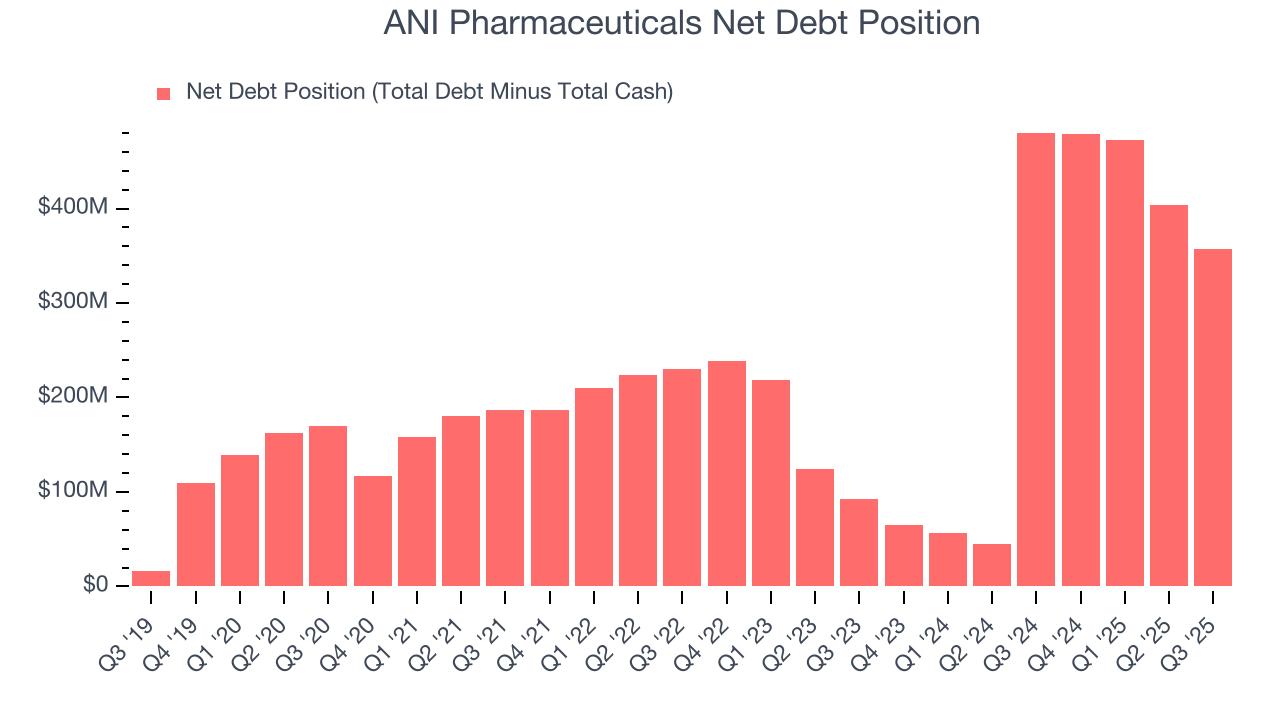
ANI Pharmaceuticals (ANIP)
We’re cautious of ANI Pharmaceuticals. Its negative returns on capital show it destroyed value by losing money on unprofitable business ventures.― StockStory Analyst Team
1. News
2. Summary
Why ANI Pharmaceuticals Is Not Exciting
With a diverse portfolio of 116 pharmaceutical products and a growing rare disease platform, ANI Pharmaceuticals (NASDAQ:ANIP) develops, manufactures, and markets branded and generic prescription pharmaceuticals, with a focus on rare disease treatments.
- Push for growth has led to negative returns on capital, signaling value destruction
- Modest revenue base of $826.9 million gives it less fixed cost leverage and fewer distribution channels than larger companies
- A consolation is that its impressive 32.9% annual revenue growth over the last five years indicates it’s winning market share this cycle


ANI Pharmaceuticals is in the doghouse. We’re redirecting our focus to better businesses.
Why There Are Better Opportunities Than ANI Pharmaceuticals
High Quality
Investable
Underperform
Why There Are Better Opportunities Than ANI Pharmaceuticals
At $82.80 per share, ANI Pharmaceuticals trades at 10.6x forward P/E. Yes, this valuation multiple is lower than that of other healthcare peers, but we’ll remind you that you often get what you pay for.
Cheap stocks can look like great bargains at first glance, but you often get what you pay for. These mediocre businesses often have less earnings power, meaning there is more reliance on a re-rating to generate good returns - an unlikely scenario for low-quality companies.
3. ANI Pharmaceuticals (ANIP) Research Report: Q3 CY2025 Update
Specialty pharmaceutical company ANI Pharmaceuticals (NASDAQ:ANIP) reported Q3 CY2025 results topping the market’s revenue expectations, with sales up 53.6% year on year to $227.8 million. The company’s full-year revenue guidance of $863.5 million at the midpoint came in 1.8% above analysts’ estimates. Its non-GAAP profit of $2.04 per share was 15.2% above analysts’ consensus estimates.
ANI Pharmaceuticals (ANIP) Q3 CY2025 Highlights:
- Revenue: $227.8 million vs analyst estimates of $214.1 million (53.6% year-on-year growth, 6.4% beat)
- Adjusted EPS: $2.04 vs analyst estimates of $1.77 (15.2% beat)
- Adjusted EBITDA: $59.6 million vs analyst estimates of $55.24 million (26.2% margin, 7.9% beat)
- The company lifted its revenue guidance for the full year to $863.5 million at the midpoint from $830.5 million, a 4% increase
- Management raised its full-year Adjusted EPS guidance to $7.51 at the midpoint, a 4.7% increase
- EBITDA guidance for the full year is $224.5 million at the midpoint, above analyst estimates of $221.9 million
- Operating Margin: 15.9%, up from -13.8% in the same quarter last year
- Market Capitalization: $1.87 billion
Company Overview
With a diverse portfolio of 116 pharmaceutical products and a growing rare disease platform, ANI Pharmaceuticals (NASDAQ:ANIP) develops, manufactures, and markets branded and generic prescription pharmaceuticals, with a focus on rare disease treatments.
ANI operates through three main business segments: rare disease treatments, generic pharmaceuticals, and established branded products. The company's flagship rare disease product is Purified Cortrophin Gel, a hormone therapy used to treat various conditions including multiple sclerosis flares, rheumatic disorders, and certain allergic states. This product represents a key growth driver for the company as it expands its presence in the high-margin rare disease market.
The company's generic business forms the backbone of its operations, with a robust development pipeline supported by its Novitium subsidiary, which has established expertise in obtaining Competitive Generic Therapy (CGT) designations from the FDA. These designations can provide 180-day market exclusivity for generic drugs that address inadequate market competition, creating valuable opportunities in niche markets.
ANI manufactures its products at three facilities located in Minnesota and New Jersey, which are capable of producing various pharmaceutical formulations including oral solids, liquids, topicals, and controlled substances. This manufacturing capability gives ANI flexibility to produce complex formulations that may have limited competition.
The company distributes its products through major pharmaceutical channels including national wholesalers like Cencora (formerly AmerisourceBergen), Cardinal Health, and McKesson, as well as retail pharmacy chains, specialty pharmacies, and group purchasing organizations. For its rare disease products, ANI works with specialty pharmacies and hospital systems to ensure patients can access these more specialized treatments.
ANI's business model balances the steady revenue from established generic and branded products with growth opportunities in rare disease treatments and niche generic markets where competition is limited due to manufacturing complexity or market size.
4. Generic Pharmaceuticals
The generic pharmaceutical industry operates on a volume-driven, low-cost business model, producing bioequivalent versions of branded drugs once their patents expire. These companies benefit from consistent demand for affordable medications, as they are critical to reducing healthcare costs. Generics typically face lower R&D expenses and shorter regulatory approval timelines compared to branded drug makers, enabling cost efficiencies. However, the industry is highly competitive, with intense pricing pressures, thin margins, and frequent legal challenges from branded pharmaceutical companies over patent disputes. Looking ahead, the industry is supported by tailwinds such as the role of AI in streamlining drug development (reverse engineering complex formulations) and manufacturing efficiency (optimize processes and remove inefficiencies). Governments and insurers' focus on reducing drug costs can also boost generics' adoption. However, headwinds include escalating pricing pressure from large buyers like pharmacy chains and healthcare distributors as well as evolving regulatory hurdles.
ANI Pharmaceuticals competes with larger pharmaceutical companies including Amneal Pharmaceuticals, Teva Pharmaceuticals USA, Sun Pharmaceutical Industries, and Viatris Inc. In the rare disease space, competitors include Mallinckrodt Pharmaceuticals and other specialty pharmaceutical companies focused on similar therapeutic areas.
5. Revenue Scale
Larger companies benefit from economies of scale, where fixed costs like infrastructure, technology, and administration are spread over a higher volume of goods or services, reducing the cost per unit. Scale can also lead to bargaining power with suppliers, greater brand recognition, and more investment firepower. A virtuous cycle can ensue if a scaled company plays its cards right.
With just $826.9 million in revenue over the past 12 months, ANI Pharmaceuticals is a small company in an industry where scale matters. This makes it difficult to build trust with customers because healthcare is heavily regulated, complex, and resource-intensive.
6. Revenue Growth
A company’s long-term sales performance is one signal of its overall quality. Any business can put up a good quarter or two, but the best consistently grow over the long haul. Over the last five years, ANI Pharmaceuticals grew its sales at an incredible 32.9% compounded annual growth rate. Its growth beat the average healthcare company and shows its offerings resonate with customers.

We at StockStory place the most emphasis on long-term growth, but within healthcare, a half-decade historical view may miss recent innovations or disruptive industry trends. ANI Pharmaceuticals’s annualized revenue growth of 35.6% over the last two years is above its five-year trend, suggesting its demand was strong and recently accelerated. 
This quarter, ANI Pharmaceuticals reported magnificent year-on-year revenue growth of 53.6%, and its $227.8 million of revenue beat Wall Street’s estimates by 6.4%.
Looking ahead, sell-side analysts expect revenue to grow 8.9% over the next 12 months, a deceleration versus the last two years. Despite the slowdown, this projection is admirable and indicates the market sees success for its products and services.
7. Operating Margin
ANI Pharmaceuticals was profitable over the last five years but held back by its large cost base. Its average operating margin of 2.1% was weak for a healthcare business.
On the plus side, ANI Pharmaceuticals’s operating margin rose by 16.1 percentage points over the last five years, as its sales growth gave it immense operating leverage.

In Q3, ANI Pharmaceuticals generated an operating margin profit margin of 15.9%, up 29.7 percentage points year on year. This increase was a welcome development and shows it was more efficient.
8. Earnings Per Share
Revenue trends explain a company’s historical growth, but the long-term change in earnings per share (EPS) points to the profitability of that growth – for example, a company could inflate its sales through excessive spending on advertising and promotions.
ANI Pharmaceuticals’s EPS grew at a spectacular 13.7% compounded annual growth rate over the last five years. Despite its operating margin improvement during that time, this performance was lower than its 32.9% annualized revenue growth, telling us that non-fundamental factors such as interest and taxes affected its ultimate earnings.

We can take a deeper look into ANI Pharmaceuticals’s earnings quality to better understand the drivers of its performance. A five-year view shows ANI Pharmaceuticals has diluted its shareholders, growing its share count by 75.7%. This dilution overshadowed its increased operational efficiency and has led to lower per share earnings. Taxes and interest expenses can also affect EPS but don’t tell us as much about a company’s fundamentals. 
In Q3, ANI Pharmaceuticals reported adjusted EPS of $2.04, up from $1.34 in the same quarter last year. This print easily cleared analysts’ estimates, and shareholders should be content with the results. Over the next 12 months, Wall Street expects ANI Pharmaceuticals’s full-year EPS of $7.17 to grow 6.7%.
9. Cash Is King
Although earnings are undoubtedly valuable for assessing company performance, we believe cash is king because you can’t use accounting profits to pay the bills.
ANI Pharmaceuticals has shown impressive cash profitability, giving it the option to reinvest or return capital to investors. The company’s free cash flow margin averaged 10.2% over the last five years, better than the broader healthcare sector. The divergence from its underwhelming operating margin stems from the add-back of non-cash charges like depreciation and stock-based compensation. GAAP operating profit expenses these line items, but free cash flow does not.
Taking a step back, we can see that ANI Pharmaceuticals’s margin expanded by 12.5 percentage points during that time. This is encouraging because it gives the company more optionality.

10. Return on Invested Capital (ROIC)
EPS and free cash flow tell us whether a company was profitable while growing its revenue. But was it capital-efficient? Enter ROIC, a metric showing how much operating profit a company generates relative to the money it has raised (debt and equity).
ANI Pharmaceuticals’s five-year average ROIC was negative 3.4%, meaning management lost money while trying to expand the business. Its returns were among the worst in the healthcare sector.

We like to invest in businesses with high returns, but the trend in a company’s ROIC is what often surprises the market and moves the stock price. Over the last few years, ANI Pharmaceuticals’s ROIC has increased. This is a good sign, but we recognize its lack of profitable growth during the COVID era was the primary reason for the change.
11. Balance Sheet Assessment
ANI Pharmaceuticals reported $262.6 million of cash and $620.3 million of debt on its balance sheet in the most recent quarter. As investors in high-quality companies, we primarily focus on two things: 1) that a company’s debt level isn’t too high and 2) that its interest payments are not excessively burdening the business.

With $214.5 million of EBITDA over the last 12 months, we view ANI Pharmaceuticals’s 1.7× net-debt-to-EBITDA ratio as safe. We also see its $21.66 million of annual interest expenses as appropriate. The company’s profits give it plenty of breathing room, allowing it to continue investing in growth initiatives.
12. Key Takeaways from ANI Pharmaceuticals’s Q3 Results
This was a beat and raise quarter. We were specifically impressed by how significantly ANI Pharmaceuticals blew past analysts’ revenue expectations this quarter. We were also glad its EPS outperformed Wall Street’s estimates. Looking ahead, full-year guidance was raised. Zooming out, we think this was a good print with some key areas of upside. The stock traded up 5.7% to $95.53 immediately after reporting.
13. Is Now The Time To Buy ANI Pharmaceuticals?
Updated: December 3, 2025 at 11:05 PM EST
A common mistake we notice when investors are deciding whether to buy a stock or not is that they simply look at the latest earnings results. Business quality and valuation matter more, so we urge you to understand these dynamics as well.
ANI Pharmaceuticals isn’t a terrible business, but it isn’t one of our picks. Although its revenue growth was exceptional over the last five years, it’s expected to deteriorate over the next 12 months and its relatively low ROIC suggests management has struggled to find compelling investment opportunities. And while the company’s rising cash profitability gives it more optionality, the downside is its subscale operations give it fewer distribution channels than its larger rivals.
ANI Pharmaceuticals’s P/E ratio based on the next 12 months is 10.6x. While this valuation is fair, the upside isn’t great compared to the potential downside. We're fairly confident there are better stocks to buy right now.
Wall Street analysts have a consensus one-year price target of $109.88 on the company (compared to the current share price of $82.80).
Although the price target is bullish, readers should exercise caution because analysts tend to be overly optimistic. The firms they work for, often big banks, have relationships with companies that extend into fundraising, M&A advisory, and other rewarding business lines. As a result, they typically hesitate to say bad things for fear they will lose out. We at StockStory do not suffer from such conflicts of interest, so we’ll always tell it like it is.









